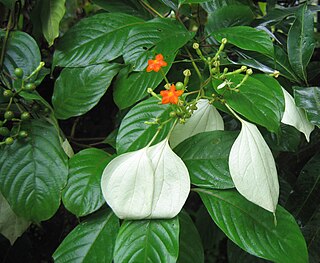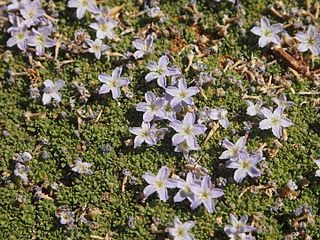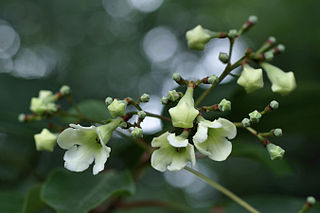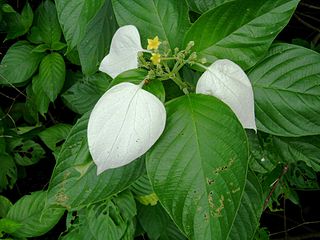
The Rubiaceae are a family of flowering plants, commonly known as the coffee, madder, or bedstraw family. It consists of terrestrial trees, shrubs, lianas, or herbs that are recognizable by simple, opposite leaves with interpetiolar stipules and sympetalous actinomorphic flowers. The family contains about 13,500 species in about 620 genera, which makes it the fourth-largest angiosperm family. Rubiaceae has a cosmopolitan distribution; however, the largest species diversity is concentrated in the tropics and subtropics. Economically important genera include Coffea, the source of coffee, Cinchona, the source of the antimalarial alkaloid quinine, ornamental cultivars, and historically some dye plants.

Galium is a large genus of annual and perennial herbaceous plants in the family Rubiaceae, occurring in the temperate zones of both the Northern and Southern Hemispheres. Some species are informally known as bedstraw.

Vallaris is a genus of plants in the family Apocynaceae first described as a genus in 1768. It is native to China, the Indian Subcontinent, and Southeast Asia.
- Vallaris anceps = Kibatalia macrophylla
- Vallaris angustifolia = Kibatalia gitingensis
- Vallaris arborea = Kibatalia macrophylla
- Vallaris clavata = Echites clavatus
- Vallaris daronensis = Kibatalia maingayi
- Vallaris divaricata = Strophanthus divaricatus
- Vallaris fimbriata = Euphorbia mammillaris
- Vallaris gitingensis = Kibatalia gitingensis
- Vallaris ipecacuanhae = Euphorbia ipecacuanhae
- Vallaris lancifolia = Micrechites lancifolius
- Vallaris laxiflora = Pottsia laxiflora
- Vallaris macrantha = Beaumontia macrantha
- Vallaris maingayi = Kibatalia maingayi
- Vallaris missurica = Euphorbia missurica
- Vallaris portulacoides = Euphorbia portulacoides
- Vallaris × uniflora = Euphorbia × uniflora

Panisea is a genus of plant in family Orchidaceae. It is native to China, the Indian Subcontinent, and Indochina.
Remijia is a genus of flowering plants in the family Rubiaceae. Within the family, it is a member of the subfamily Cinchonoideae and the tribe Cinchoneae.
Amaracarpus is a genus of shrubs, treelets or trees in the family Rubiaceae. It was described by Carl Ludwig Blume in 1826. Most of the species are endemic to New Guinea but a few have wider ranges in Southeast Asia from Myanmar (Burma) and the Andaman Islands across Thailand, Malaysia, Indonesia, the Philippines, Melanesia, Christmas Island, Queensland and Vanuatu. One species also occurs in the Seychelles. Several species were published years ago but are today not represented by any type specimens or other known existing material.
Brachytome is a genus of 8 species of flowering plants in the family Rubiaceae. It was described by Joseph Dalton Hooker in 1871. It occurs in mainland Southeast Asia from Bangladesh, east to south central China and south to Peninsular Malaysia.
Bremeria is a genus of flowering plants in the family Rubiaceae. It was described in 2005 to accommodate all the Indian Ocean species formerly placed in Mussaenda, except the widespread Mussaenda arcuata. The genus is indigenous to Madagascar, Mauritius and Réunion, and is found in humid to subhumid evergreen forests.
Edrastima is a genus of flowering plants in the family Rubiaceae. The genus widespread and is found in Central and Eastern USA and the tropics and subtropics.

Catunaregam is a genus of flowering plants in the family Rubiaceae, native to tropical Africa and tropical Southeast Asia.

Mussaenda is a genus of flowering plants in the family Rubiaceae. They are native to the African and Asian tropics and subtropics. Several species are cultivated as ornamental plants.

Mussaenda frondosa, commonly known as the wild mussaenda or dhobi tree, is a plant of family Rubiaceae. It is a shrub that grows to about 1.5–2 m tall. Like most other Mussaenda species, they have a bract beneath their flowers, which in this species is white in colour.
Clarkella is a monotypic genus of flowering plants in the family Rubiaceae. The genus contains only one species, viz. Clarkella nana, which is native to India, China, Uttarakhand, the Western Himalayas, Burma and Thailand.
Khasiaclunea is a genus of plants in the family Rubiaceae. It has only one known species, Khasiaclunea oligocephala, known from the high mountains of the Darjeeling region of India through Assam and Bhutan to Burma (Myanmar).

Dentella is a genus of flowering plants in the family Rubiaceae. Most species genus are endemic to Australia, with one species also extending through southeast Asia to subtropical Asia and the southwestern Pacific.

Emmenopterys is a genus of flowering plants in the family Rubiaceae. The genus is found in China, Burma, Thailand, and Vietnam.

Mussaendeae is a tribe of flowering plants in the family Rubiaceae and contains about 221 species in 8 genera. Its representatives are found from tropical and southern Africa, the western Indian Ocean, to tropical and subtropical Asia and the Pacific region.

Mussaenda philippica is a plant species in the family Rubiaceae that grows as a shrub or small tree. Native to the Philippines it is commonly grown elsewhere as an ornamental species. Known varieties include: "Doña Luz" (pink), "Doña Alicia", "Queen Sirikit", "Doña Aurora" (white), and "Doña Eva".

Mussaenda raiateensis, commonly known as the Pacific mussaenda or Pacific flag-tree, is a plant of family Rubiaceae native to Tonga, Samoa, the Cook Islands and Society Islands in the South Pacific Ocean.

Mussaenda parviflora is a species of flowering plant in the family Rubiaceae, native to Yakushima and the Ryukyu Islands of Japan, Taiwan, and Guangdong, China. A climbing shrub, it flowers March to May and fruits from August all the way to January.











